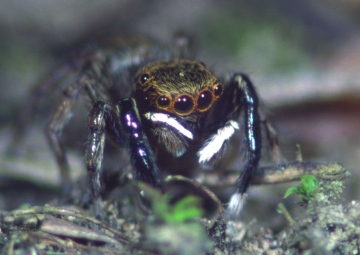Summary for Euophrys frontalis (Araneae)
previous species | next species
National Distribution
Terms of Use. Double-click on map to go to region

Explore Regional Distribution
View notes or log on and add a note on this species
About this species
Recorded altitude range0m to 673m
Species text
DistributionThe species is widespread in the southern half of Britain, with a few mainly coastal records further north. It is widespread in western and central Europe.
Habitat and ecology
As in central Europe (see Hänggi et al. (1995)), this spider does not seem to have a well-defined habitat niche in Britain, although it seems particularly abundant in grasslands and heaths. E. frontalis has a rather catholic diet, which may include insect eggs. It is only caught during the day. Males can be observed acting out their complex courtship which involves behavioural cues using both their legs and palps (Bristowe 1929, 1958). During a resting period, E. frontalis may be found in a silken cell placed under stones or in litter. Females guard the egg-sacs which contain around 20 eggs each (Bristowe 1958). Adults of both sexes have been recorded between April and October, but mainly in May, June and July with females occasionally persisting into the autumn and winter.
Status
Common in the south.
Original author of profile: J.R. Bell
Text based on Harvey, P.R., Nellist, D.R. & Telfer, M.G. (eds) 2002. Provisional atlas of British spiders (Arachnida, Araneae), Volumes 1 & 2. Huntingdon: Biological Records Centre. References
Adult Season
Habitats
background methodology
Recorded management for locations with Euophrys frontalis
Recorded substrate and hydrology for locations with Euophrys frontalis
Images
please log on and upload a new image for this speciesSee also A-Z Species Index - A-Z Picture Index - previous species | next species










